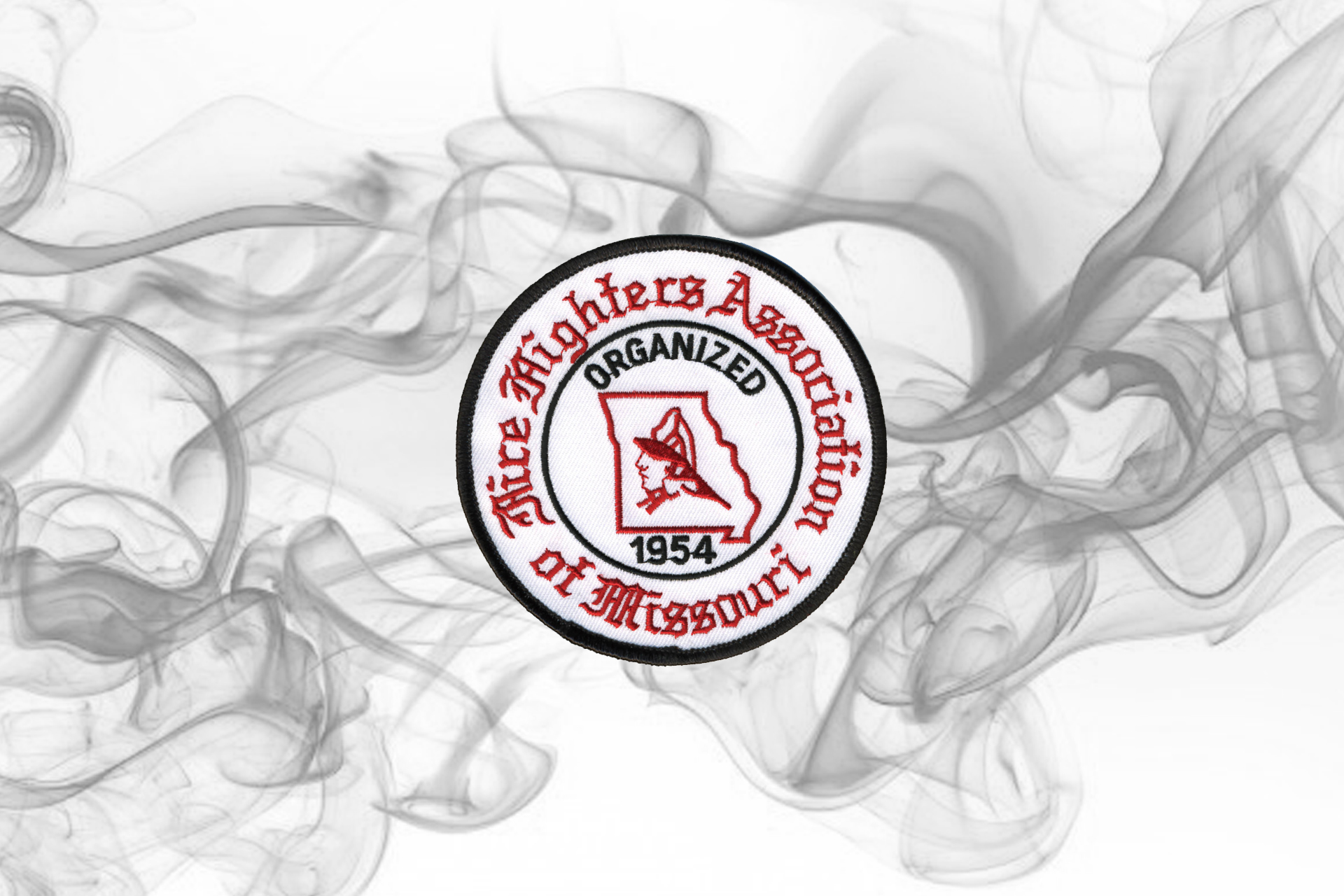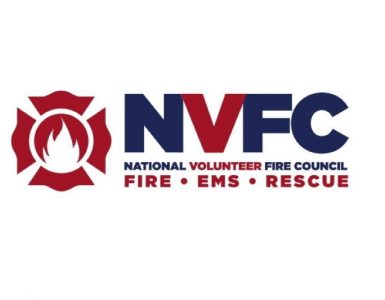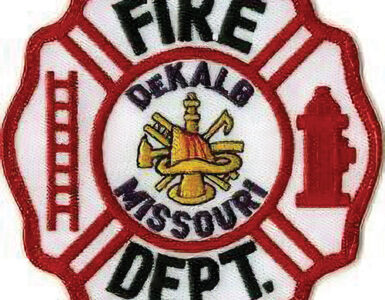MISSOURI TASK FORCE 1
THE NATIONAL URBAN SEARCH AND RESCUE RESPONSE SYSTEM
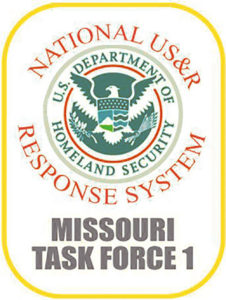 FEMA Urban Search and Rescue Task Forces are teams of individuals specializing in urban search and rescue, disaster recovery, and emergency triage and medicine. The teams are deployed to emergency and disaster sites within six hours of notification. The Federal Emergency Management Agency (FEMA) created the task force concept in 1989 to provide support for large-scale disasters.
FEMA Urban Search and Rescue Task Forces are teams of individuals specializing in urban search and rescue, disaster recovery, and emergency triage and medicine. The teams are deployed to emergency and disaster sites within six hours of notification. The Federal Emergency Management Agency (FEMA) created the task force concept in 1989 to provide support for large-scale disasters.
There are twenty-eight task forces in the country, each sponsored by a local agency. In the event of a major incident in the United States, the nearest three task forces will be activated and sent to the site of the disaster. If the situation warrants, additional teams will be activated.
MISSOURI URBAN SEARCH AND RESCUE TASK FORCE 1
The Boone County Fire Protection District manages Missouri Task Force 1 (MO-TF1). The Task Force is designed to assist local emergency agencies facing disaster responses both in and outside the state. The task force supplements local response agencies and does not command or control the incident. When it deploys, the team consists of eighty people. To insure eighty individuals can deploy at any given time, federal requirements mandate that each position be staffed three deep. In total, 210 people are necessary to properly staff MO-TF1. These people fill eighteen separate and distinct job functions ranging from canine search specialists, to physicians, to rescue specialist, and heavy equipment operators. Nationally, over 2,000 individuals are involved in the FEMA Urban Search and Rescue Task Force System.
MO-TF1 has more than 17,000 separate equipment items that are maintained in inventory and sent when the task force is deployed. The total equipment cache weight is in excess of 40,000 pounds. The unit must carry everything necessary to be self-sufficient for up to 72 hours.
In 2013 Boone Electric Cooperative featured the task force in an article in their publication. The following reprint of that article features an interview with long time Task Force Leader, Assistant Chief Doug Westhoff and illustrates the real concept of the task force system and the dedication required to make the system work.
Leading a Team of Heroes – A Boone Electric Coop Article
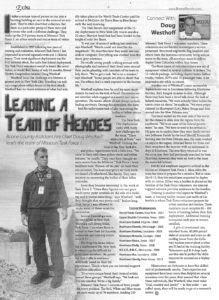 It takes a unique type of person to run into a burning building or race to the scene of an accident. They’re often described as heroes. But there is a particular group of these men and women who seek a different challenge. They make up the 210 person team of Missouri Task Force 1, and urban search and rescue team of volunteers.
It takes a unique type of person to run into a burning building or race to the scene of an accident. They’re often described as heroes. But there is a particular group of these men and women who seek a different challenge. They make up the 210 person team of Missouri Task Force 1, and urban search and rescue team of volunteers.
Established in 1997 following two years of training, Missouri Task Force 1 has responded to several regional events and 11 federal events. Their most significant deployment was the 9-11 terrorist attack, the unit’s first federal deployment. The Task Force volunteers would be tested like never before, as would leader of only 14 months, Boone Electric Cooperative member Doug Westhoff.
Westhoff faced the challenge of a lifetime at ground zero in New York City. Traveling via military cargo plane within minutes of the first attack, Westhoff had no visual evidence of what had actually taken place at the World Trade Center until he arrived early the next morning.
The Task Force’s first assignment of the eleven day deployment to New York City was to search a 29 story Marriott hotel that had been leveled to the height of only five floors.
“It was just 16 acres of nothing but nastiness,” He describes how they never was one desk or computer. Everything was crushed into this dusty, gray substance.
He recalls seeing people walking around with photographs and names of their loved ones around their necks, pleading with members of his team to help them “We’ve got a task. We’re on a mission,” says Westhoff. “Some people are able to shield that out. For others that’s a stark exposure to the human life.”
Westhoff explains how he and his team must remain focused on the task at hand. Emotions cannot interfere while engaged in a search and rescue operation. The team’s efforts do not always include finding survivors. During this operation, the team had the unfortunate task of also recovering the bodies of fellow rescue workers.
The New York City deployment came with many new challenges for the team. “There were a lot of firsts,” says Westhoff. Gaining the trust of the New York fire and police departments took a little time. “We came in there with these yellow shirts and yellow helmets,” he recalls. “They must have thought we were cavers from the Midwest. “Task Force 1 team members were “thrown off the pile” on more than one occasion. The local emergency services workers shared a brotherhood, like family. They were insistent on recovering the bodies of their fallen comrades.
Soon they became interested in the work of Task Force 1. “Once they figured out their guys could spray paint symbols on the side of a building and it meant something,” says Westhoff, “well, they thought that was pretty cool.” Before long, Task Force 1 was allowed to make some of those sensitive recoveries.
Several friendships were formed while in New York. Many are still strong today. Task Force 1 members have returned to New York for funerals, memorials and training events since 9-11.
The long trip home following a deployment like New York is when it can be difficult for some team members. He points out that it affects everyone differently based on their life experiences. This is where you see internal supportive efforts take place.
“It’s a very unique bond that’s formed within one of these groups,” Westhoff says. “ We look out for one another. We’re a big family.”
Missouri Task Force 1 consists of three people for every position. The Red, White and Blue teams are each made up of 70 members, totaling 210 Missouri Task Force 1 volunteer members. These volunteers are not limited to emergency service personnel. Structural engineers, dog handlers and others from the business community bring unique assets to the team. All members must be able to deploy from Columbia within three hours.
The three teams of volunteers share one set of equipment valued at several millions of dollars. The 12 vehicle package, including charter buses, flatbed trucks, trailers, SUVs and 15 passenger vans, is an impressive site while in transit.
Another one of Westhoff’s most memorable deployments was to Louisiana following Hurricane Katrina, their longest mission to date. Although there may have been a lot of talk about the lack of federal resources, “We were actually there before the storm came on shore,” he explains. “We were pre-positioned in Shreveport, LA.”
The team waited on the west side of the storm for the chance to slide into the region from the southwest. “We’re an asset of the federal government,” he says. “We have to wait to be invited in.” He goes on to explain how they were finally invited into Jefferson Parish by the local Sheriff. Eventually moving into the New Orleans area, the team worked 14 days in the region, returned home for three and then completed the mission with an additional 14 days in Louisiana. The area they returned to was the same area they had previously searched by boat. This time, however, they were on foot in the mess the water left behind.
Family and employer support is critical to the success of Missouri Task Force 1. Most often the team has time to prepare for a mission. But in cases like 9-11, they are sometimes requested to deploy with no notice. Either way, a burden is placed on families of the Task Force volunteers. An internal support network provides assistance to the families.
Training is another vital aspect to Westhoff’s team. A training facility located just north of Columbia is where Task Force volunteers prepare for urban searches and rescues. Team members must complete 80-100 hours of training before their first deployment. Additional training is required each year to remain certified.
A pile of overturned cars, smashed buses, 40,000 pound slabs of concrete and even an old cooling tower from the Callaway nuclear power plant is what you’ll find at the training facility. Volunteers and K-9 dogs both use this site to perfect the skills required to succeed on a deployment.
Missourians are fortunate to have this skilled unit of professionals nearby. Their expertise and equipment have been more than helpful on several occasions over the years. Rest assured that when these individuals, like Westhoff, who most value “God, country and family” – in that order – are called upon, they will be ready to go at a moment’s notice.
Task Force 1 Headquarters

If MO-TF1 is deployed and air transportation is required, the entire cache of equipment, all sixty thousand pound of it, along with personnel is transported to Whiteman A.F.B by ground from it’s base at Boone County Fire District Headquarters in Columbia MO to be airlifted to the incident. The deployment to New York on 9/11 was one such deployment. There are over 16,000 pieces of equipment needed to support the task force rescue and recovery efforts. The nearly one and a half million dollars worth of equipment, along with nearly one hundred task force members, will completely fill a military C-141 aircraft or two C-130’s.
In the majority of instances when MO-TF1 is required, ground transportation is the most logical approach to reaching the scene. The entire cache of equipment is stored in “transportation ready” containers in the task force warehouse at the Boone County Fire District Headquarters in Columbia. Logistics specialist load tractor-trailer units as task force members make their way from their home bases to Columbia for deployment. To ensure rapid and effective response, the task force cache must be a construction site, communications center, high-tech engineering firm, mobile emergency room and camp rolled into one.
FIRST FEDERAL DEPLOYMENT
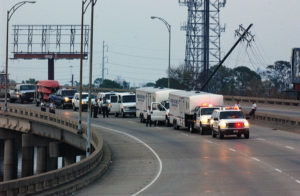
Jocelyn Augustino/FEMA
Missouri Task Force 1 was formed after several years of discussion and political maneuvering to convince FEMA officials that Boone County Fire Protection District in Columbia, Missouri, was the best destination for a federal task force of this magnitude. According to retired Boone County Fire Chief Steve Paulsell, who was the driving force behind the effort, U.S. Senator Christopher Kit Bond played an important role in Washington to insure that FEMA officials knew the importance of the task force being centrally located in the State. He also assured FEMA Director James Lee Whitt that the district and its staff were up to the challenge. It was also imperative that the district demonstrates to FEMA that a serious search and rescue capability exist in the district before final approval could be granted. Missouri Senator Roger Wilson acquired a rather large appropriation from the Missouri legislature to insure that Boone County could provide the basic format required to satisfy FEMA Requirements.
After FEMA approval there was a couple of year span of intense training and organization to bring Missouri Task Force 1 to an operational status. Assistant Chief Doug Westhoff was appointed by Chief Pausell to be the task force leader and he and other staff members trained with other task forces around the country to insure operational readiness. Members of the task force were recruited from not only the Boone County Fire District but also from fire departments throughout the State of Missouri.
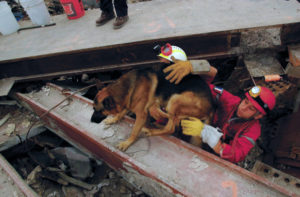
Photo by Andrea Booher/ FEMA News Photo
It was on September 11, 2001, when all the training and efforts put forth by all the hundreds of task force members would be put to the test. The attack on the morning of 9/11 triggered the most significant response in history of the Federal Emergency Management Agency’s (FEMA) Urban Search and Rescue National Response System. The attacks prompted a Presidential Disaster Declaration under the Stafford Act and the activation of the Federal Response Plan.
Of the eight initial task force’s activated by FEMA, four responded by ground transportation Pennsylvania (PA-TF1), Massachusetts (MA-TF1), Ohio (OH-TF1) and Indiana (IN-TF1). The other four teams activated responded by military airlift California (CA-TF1) (CA-TF6) (CA-TF7) and Missouri (MO-TF1).
By the middle of the afternoon on September 11, MO-TF1 was on its way to Whiteman A.F.B to be air lifted to McGuire A.F.B. and its first and most challenging deployment of many to come in the following years.
DEPLOYMENTS
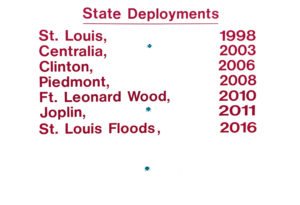
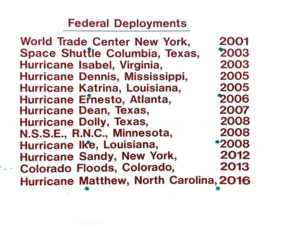 Over the last two decades, MO-TF1 has deployed to Federal deployments outside Missouri and a number on in state emergencies. A deployment requires swift and efficient loading and transportation of equipment and personnel, both human and canine, in busses, tractor trailers, and a parade of other vehicle that travel in an emergency response convoy. On each of the trailer units is a list of deployments executed by MO-TF1 over the years.
Over the last two decades, MO-TF1 has deployed to Federal deployments outside Missouri and a number on in state emergencies. A deployment requires swift and efficient loading and transportation of equipment and personnel, both human and canine, in busses, tractor trailers, and a parade of other vehicle that travel in an emergency response convoy. On each of the trailer units is a list of deployments executed by MO-TF1 over the years.
Hurricane MATTHEW DEPLOYMENT, OCTOBER 2016,
LUMBERTON, NORTH CAROLINA
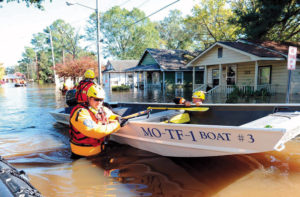 One of the most current MO-TF1 out state Federal deployments was a result of the massive flooding in the Southeast United States as a result of hurricane Matthew. The best way to get an idea of the massive activities of the task force is to review some of the official FEMA photos taken during that activity when MO-TF1 members were assisting families affected by flooding in Lumberton, NC.
One of the most current MO-TF1 out state Federal deployments was a result of the massive flooding in the Southeast United States as a result of hurricane Matthew. The best way to get an idea of the massive activities of the task force is to review some of the official FEMA photos taken during that activity when MO-TF1 members were assisting families affected by flooding in Lumberton, NC.
Task forces are assigned locations of operation by FEMA and upon arrival establish a base of operation (BOO) so that coordination can take place with local emergency officials. Each member is assigned to a twelve hour shift and rescue and recovery operations normally take on a twenty-four hour a day format, depending on the area and need.
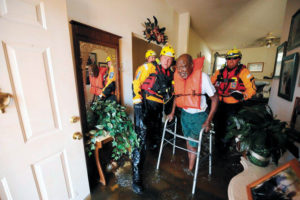 These dedicated task force members come from throughout the state and spend countless hours in regularly scheduled training at the Task Force/BCFPD training center North of Columbia, as well as deployments. We are indeed fortunate to have such an organization in our state. Thank you to all that serve and have served with the FEMA Missouri Urban Search and Rescue Task Force 1.
These dedicated task force members come from throughout the state and spend countless hours in regularly scheduled training at the Task Force/BCFPD training center North of Columbia, as well as deployments. We are indeed fortunate to have such an organization in our state. Thank you to all that serve and have served with the FEMA Missouri Urban Search and Rescue Task Force 1.
Editors Note: A special thanks to Boone Electric Cooperative for allowing us to use their article Leading a Team of Heroes and to FEMA Photographer Jocelyn Augustina for the exceptional photos. Our thanks and gratitude also goes out to Fire Chief Scott Olsen and the Board of Directors of the Boone County Fire Protection District for the continued sponsorship of this important state asset. Last but certainly not least, the full time staff at the fire district, including my epic Son, who lives and breaths the task force and the fire district and has for forty years, and all the other folks that “keep the wheels on” the task force!


